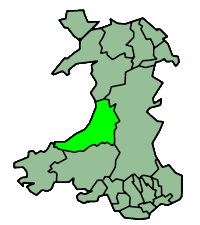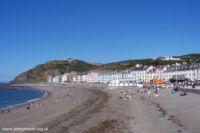Aberystwyth
2007 Schools Wikipedia Selection. Related subjects: Geography of Great Britain
| Aberystwyth | |
| Population | 11,607 (2001) |
|---|---|
| OS grid reference | |
| Principal area | Ceredigion |
| Ceremonial county | Dyfed |
| Constituent country | Wales |
| Sovereign state | United Kingdom |
| Post town | ABERYSTWYTH |
| Postcode district | SY23 |
| Dial code | 01970 |
| Police | Dyfed-Powys |
| Fire | Mid and West Wales |
| Ambulance | Welsh |
| UK Parliament | Ceredigion |
| European Parliament | Wales |
| List of places: UK • Wales • Ceredigion | |
Aberystwyth ( IPA: [abɛrˈəstwɪθ], South Welsh: [abɛrˈəstɔʏθ]) (in English: Mouth of the Ystwyth) is a historic market town, administrative centre and holiday resort within Ceredigion, Wales. It is often called just "Aber".
In modern times Aberystwyth has become a major Welsh educational centre. The indigenous population is around 12,000, but is swelled by an additional 9,232 (2006) students associated with the University of Wales, Aberystwyth. Thus for nine months of the year, Aberystwyth's population is around 21,000 people. The world's first department in international politics was established in Aberystwyth in 1919. It is also the home of the only AMBA accredited MBA programme in Wales. "Aber" is acknowledged as being Wales' spiritual capital.
Geography
The town is situated near the confluence of the rivers Ystwyth and Rheidol, about midway down the length of Cardigan Bay. Although the name may seem to suggest otherwise, only the River Rheidol actually passes through the town - the River Ystwyth only just skirts the town, following the reconstruction of the harbour.
Aberystwyth has a pier and a fine sea-front which stretches from Constitution Hill at the north end of the Promenade to the mouth of the harbour at the south.
Brief information
Aberystwyth is a major tourist centre and a cultural link between the north and south of Wales. Constitution Hill is scaled by the Aberystwyth Electric Cliff Railway giving access to fine views and other attractions at the top, while much of the finest scenery in Mid Wales lies within easy reach of the town. This includes the wilderness of the Cambrian Mountains, whose valleys contain forests and meadows which have little changed in centuries. A convenient way of reaching the interior is by the preserved narrow gauge Vale of Rheidol railway.
Although the town is relatively modern, it contains a number of historic buildings, including the remains of the castle and the old buildings of the University College of Wales nearby, which could well be said to be similar aesthetically to that of Hogwarts Castle in the Harry Potter series. The Old College was originally intended to be a hotel, but due to a lack of funds the shell of the building was sold to the university. The new university campus overlooks Aberystwyth from Penglais Hill to the east of the town centre. The terminus for the standard gauge railway is also very impressive being built in 1924 in typical style of the period.
The architecture is a mix of Gothic, Classical Revival and Victorian, and the town is sometimes referred to as "the Oxford of Wales".
The town is generally regarded as the capital of Mid Wales, and several institutions have regional offices there. Perhaps the most important of the public bodies located in Aberystwyth is the National Library of Wales. The library also incorporates the National Screen and Sound Archive of Wales, one of six British regional film archives. The Royal Commission on the Ancient and Historical Monuments of Wales, which maintains and curates the National Monuments Record of Wales (NMRW), provides the public with information about the built heritage of Wales. Aberystwyth is also the site of the Institute of Grassland and Environmental Research.
Aberystwyth is twinned with St Brieuc, Brittany and Kronberg im Taunus, Germany.
History
Mesolithic
There is evidence that during the Mesolithic Age the area of Tan-y-Bwlch at the foot of Pen Dinas was used as a flint knapping floor for hunters making weapons from flint that was deposited as the ice retreated.
Celtic
The remains of a celtic fortress on Pen Dinas, a hill in Penparcau overlooking Aberystwyth, indicates that the site was inhabited before 700 BC. On a hill south of the present town, across the River Ystwyth, are the remains of a medieval ringfort believed to be the castle from which Princess Nest was abducted. This rare survival is now on private land and can only be accessed by arrangement.
Middle Ages
However, the recorded history of Aberystwyth may be said to date from the building of a fortress on the present Castle Hill, in 1109. Edward I rebuilt Strongbow's Castle in 1277, after its destruction by the Welsh. Between the years 1404 and 1408 Aberystwyth Castle was in the hands of Owain Glyndŵr, but finally surrendered to Prince Harry (the future King Henry V of England). Shortly after this the town was incorporated under the title of Ville de Lampadarn (the ancient name of the place being Llanbadarn Gaerog, or the fortified Llanbadarn, to distinguish it from Llanbadarn Fawr, the village one mile inland). It is thus styled in a charter granted by Henry VIII, but by Elizabeth I's time the town was invariably termed Aberystwyth in all documents. In 1647 the Parliamentarian troops razed the castle, so that its remains are now inconsiderable, though portions of three towers still exist. Excavations in the 1970s within the castle, in what is believed to be a stables area, revealed a complete male skeleton, deliberately buried. Rarely surviving in Wales' acidic soil, this skeleton was probably preserved by the addition of lime from the collapsed building. Affectionately known as "Charlie", he probably dates from the Civil War period, probably dying during the Parliamentarian siege and is now housed in the Ceredigion Museum in the town.
Victorian era
The Cambrian Railway line from Machynlleth reached Aberystwyth in the 1860s closely followed by rail links to Carmarthen which resulted in the construction of the town's impressive station. The railway's arrival gave rise to something of a Victorian tourist boom and the town was once even billed as the "Biarritz of Wales" . During this time a number of hotels and fine town houses were built including the Queens Hotel. One of the largest of these hotels 'The Castle Hotel' was never completed as a hotel but following bankruptcy was sold cheaply to the 'Welsh National University Committee', a group of people dedicated to the creation of a Welsh University. The University College of Wales (later to become the University of Wales, Aberystwyth) was founded in 1872 in this building.
Aberystwyth was a contributory parliamentary borough until the Third Reform Act, which caused its representation to be merged into that of the county in 1885.
Modern History
The Vale of Rheidol Railway narrow gauge line from Devil's Bridge was constructed between 1901 and 1902, intended to ship mineral traffic, primarily lead, from Devil's Bridge down to Aberystwyth for trans-shipment. By the time it was finished the lead mines were in a deep downturn and it therefore came to rely largely on the tourist industry. The railway opened for passengers in December 1902. It is still open for the summer season today.
On the night of Friday 14th January 1938 a storm with estimated wind speeds of up to 90 mph struck the town. Most of the promenade was destroyed, along with 200 feet of the pier. Most properties on the seafront were damaged, most severely on Victoria Terrace.
Cymdeithas yr Iaith Gymraeg held their historic first protest on Trefechan Bridge in Aberystwyth, back in 1963, and here also the first ever independent Welsh Evangelical Church was established (see Evangelical Movement of Wales).
Merched y Wawr have their national headquarters in Aberystwyth.
Aberystwyth hosted the National Eisteddfod in 1865, 1916, 1952 and 1992.
On March 1st, 2005, Aberystwyth was granted Fairtrade Town status.
Tourist facilities
The town boasts:
- A funicular railway and a camera obscura on Constitution Hill (known as Consti to locals)
- A golf course
- A marina
- A cinema
- A tour company specialising in day trips of the local aarea
- A paint-balling centre
- An Arts Centre featuring three theatre spaces, a cinema, 2d and 3d art studios, three art galleries, a photographic darkroom, rehearsal spaces, a bookshop, a craft shop, a dance school, three bars, a cafe and a restaurant
- A university
- A local museum
- A steam railway (The aforementioned narrow gauge Vale of Rheidol Railway)
- A microbrewery (Flannery's) which no longer brews beer in the town
- The smallest commercial brewery in the world at the Tynllidiart Arms in Capel Bangor (Guiness World Record Holder).
- A castle ruins (see history section)
- The Old College historical seafront university building.
Transport
Two of Wales's important trunk roads, the A487 and A44 meet in the town, with much traffic between north and south-west Wales passing through.
Arriva Trains Wales provide a roughly two-hourly service over the scenic Cambrian Line to Shrewsbury and Birmingham via Machynlleth and Mid Wales. Connecting services from Machynlleth also provide a link to Gwynedd's west coast.
Aberystwyth is also a hub for Wales's TrawsCambria bus network, with regular direct services to Bangor, Cardigan, Carmarthen and Cardiff. A daily National Express coach to London and Birmingham also exists.
The preserved Vale of Rheidol railway provides a convenient transport link during the summer months to Devil's Bridge, a tourist attraction about 12 miles east of the town.
Music
Within Wales, Aberystwyth is known for its music scene which has produced successful bands and artists such as.
- The Crocketts
- Hot Puppies
- Black Russian
- Pagan Wanderer Lu
In fiction
Aberystwyth (albeit an alternate universe version) is the setting for the cult Louie Knight series which transfers Chandeleresque "noir" stories and dialogue to this small seaside town. This alternate reality features many landmarks of Aberystwyth such as the university and the National Library of Wales, but the social situation is radically altered to more closely resemble the pulp/noir stereotypical 'Dirty Town' that the narrative plays off of. Most of the humour in the books is derived from the almost seamless juxtaposition of the real Aberystwyth and the fictional, noir Aberystwyth. Various aspects of Welsh culture are reflections of what you might expect to see in reality, but with a pulp twist - for example, prostitutes wear Welsh stovepipe hats.
In the setting for Classic Battletech, a star system in the Timbuktu Theatre of Alarion Provence of the Lyran Commonwealth / Lyran Alliance is named Aberystwyth.
The local writer Niall Griffiths has set many of his novels here and reflects local slang, settings and even individuals. 'Grits', 'Stump', and 'Sheepshagger' are set wholly in Aberystwyth and it also features prominently in his other novels such as Kelly and Victor and 'Stump.' He portrays a more gritty side of Aberystwyth.
Nancy Bond's "A String in the Harp" is set in the small coastal town of Borth, near Aberystwyth . The main characters' father is on sabbatical from Amherst University and working at the University of Wales, Aberystwyth.

